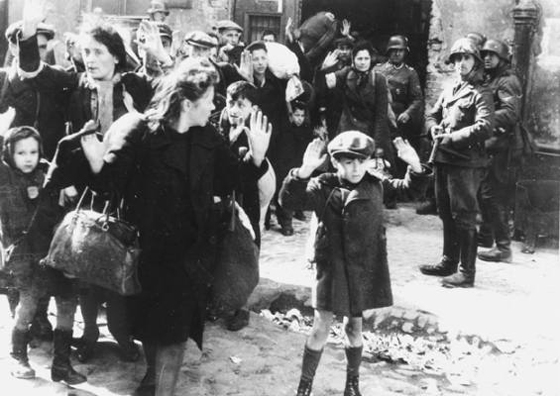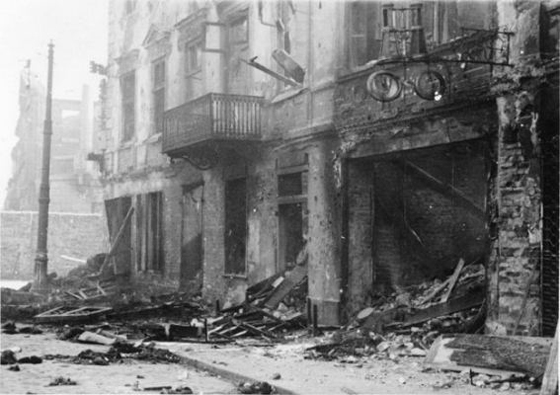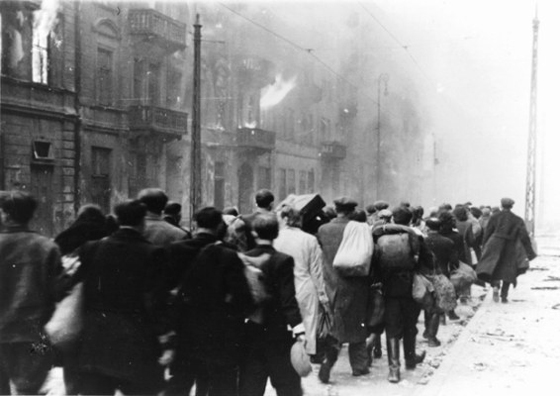Warsaw Ghetto Uprising
The event known as the Warsaw Ghetto
Uprising began on April 19, 1943 and ended on May 16, 1943. A
total of 56,065 Jews were captured by the Germans during the
uprising, and around 6,000 were killed during the destruction
of the buildings in the ghetto.

All the photos on this page are from
the photo album of Jürgen Stroop, the Commander of the SS
troops who put down the Warsaw Ghetto Uprising in 1943. There
are 50 photos included in The Stroop Report, which documents
the destruction of the Warsaw Ghetto during this action.
In spite of the fact that the photo above
is included in the Stroop Report, which was compiled during April
and May, 1943, it was identified by Holocaust survivor Tsvi C.
Nussbaum as a photo taken after the Warsaw Ghetto Uprising on
July 13, 1943 in front of the Hotel Polski on the Aryan side
of the Warsaw ghetto, where some Jews had been living as Gentiles.
Nussbaum claims that he is the seven-year-old boy in the photo
and that the woman on his left is his aunt. Since Nussbaum and
his aunt had foreign passports, they were sent to the Bergen-Belsen
detention camp as "exchange Jews."
The soldier, who is holding a gun on
the little boy in the photo, was Josef Blösche; he was put
on trial in East Germany after the war and was executed after
being convicted of participating in the action to put down the
Warsaw Ghetto Uprising.


Beginning in June 1942, the Jews in the
Warsaw Ghetto were transported to the Treblinka death camp on the Bug river, near
the eastern border of German-occupied Poland, where they were
immediately killed in gas chambers. Eventually, reports of the
mass murder got back to the Warsaw Ghetto and a resistance organization
called the Z.O.B. (Zydowska Organizacja Bojowa) was formed to
prevent any more deportations from the ghetto. The leader of
the Z.O.B. was Mordecai Anielewicz.
In January 1943, the Jews in the Warsaw
Ghetto resisted the next round-up for deportation to Treblinka;
the young Z.O.B fighters fired on German troops as they tried
to get the Jews into railroad cars to be transported to the death
camp. The Germans retreated after four days of fighting and the
Jews began to prepare to hold out against future attempts to
liquidate the ghetto.
The following quote is from the opening
statement by Robert Jackson at the Nuremberg International Military
Tribunal in which he reads from the Summary of the Stroop Report:
It is the original report of the SS
Brigadier General Stroop in charge of the destruction of the
Warsaw Ghetto, and its title page carries the inscription "The
Jewish ghetto in Warsaw no longer exists." It is characteristic
that one of the captions explains that the photograph (the photo shown at the top of this page) concerned
shows the driving out of Jewish "bandits"; those whom
the photograph shows being driven out are almost entirely women
and little children. It contains a day-by-day account of the
killings mainly carried out by the SS organization, too long
to relate, but let me quote General Stroop's summary:
"The resistance put up by the
Jews and bandits could only be suppressed by energetic actions
of our troops day and night. The Reichsfuehrer SS ordered, therefore,
on 4/23/1943, the cleaning out of the ghetto with utter ruthlessness
and merciless tenacity. I, therefore, decided to destroy and
burn down the entire ghetto without regard to the armament factories.
These factories were systematically dismantled and then burned.
Jews usually left their hideouts, but frequently remained in
the burning buildings and jumped out of the windows only when
the heat became unbearable. They then tried to crawl with broken
bones across the street into buildings which were not afire.
Sometimes they changed their hideouts during the night into the
ruins of burned buildings. Life in the sewers was not pleasant
after the first week. Many times we could hear loud voices in
the sewers. SS men or policemen climbed bravely through the manholes
to capture these Jews. Sometimes they stumbled over Jewish corpses:
sometimes they were shot at. Tear gas bombs were thrown into
the manholes and the Jews driven out of the sewers and captured.
Countless numbers of Jews were liquidated in sewers and bunkers
through blasting. The longer the resistance continued the tougher
became the members of the Waffen SS, Police and Wehrmacht who
always discharged their duties in an exemplary manner. Frequently
Jews who tied to replenish their food supplies during the night
or to communicate with neighboring groups were exterminated.
"This action eliminated,"
says the SS commander, "a proved total of 56,065. To that,
we have to add the number killed through blasting, fire, etc.,
which cannot be counted." (1061- PS)
This page was last updated on March 10,
2010
|